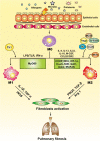Macrophages: friend or foe in idiopathic pulmonary fibrosis?
- PMID: 30189872
- PMCID: PMC6127991
- DOI: 10.1186/s12931-018-0864-2
Macrophages: friend or foe in idiopathic pulmonary fibrosis?
Abstract
Idiopathic pulmonary fibrosis (IPF) is a prototype of lethal, chronic, progressive interstitial lung disease of unknown etiology. Over the past decade, macrophage has been recognized to play a significant role in IPF pathogenesis. Depending on the local microenvironments, macrophages can be polarized to either classically activated (M1) or alternatively activated (M2) phenotypes. In general, M1 macrophages are responsible for wound healing after alveolar epithelial injury, while M2 macrophages are designated to resolve wound healing processes or terminate inflammatory responses in the lung. IPF is a pathological consequence resulted from altered wound healing in response to persistent lung injury. In this review, we intend to summarize the current state of knowledge regarding the process of macrophage polarization and its mediators in the pathogenesis of pulmonary fibrosis. Our goal is to update the understanding of the mechanisms underlying the initiation and progression of IPF, and by which, we expect to provide help for developing effective therapeutic strategies in clinical settings.
Keywords: Alternatively activated (M2) macrophages; Classically activated (M1) macrophages; IPF; Macrophage polarization; Therapeutic strategies.
Conflict of interest statement
Ethics approval and consent to participate
Not applicable.
Consent for publication
Not applicable.
Competing interests
The authors declare that they have no competing interests.
Publisher’s Note
Springer Nature remains neutral with regard to jurisdictional claims in published maps and institutional affiliations.
Figures


Similar articles
-
Macrophage polarization and its impact on idiopathic pulmonary fibrosis.Front Immunol. 2024 Jul 26;15:1444964. doi: 10.3389/fimmu.2024.1444964. eCollection 2024. Front Immunol. 2024. PMID: 39131154 Free PMC article. Review.
-
[Research progress on the role and mechanism of 5-hydroxytryptamine and M2 macrophages in pulmonary interstitial fibrosis].Zhonghua Wei Zhong Bing Ji Jiu Yi Xue. 2023 Sep;35(9):1004-1008. doi: 10.3760/cma.j.cn121430-20230724-00549. Zhonghua Wei Zhong Bing Ji Jiu Yi Xue. 2023. PMID: 37803964 Review. Chinese.
-
Regulation of alveolar macrophage death in pulmonary fibrosis: a review.Apoptosis. 2023 Dec;28(11-12):1505-1519. doi: 10.1007/s10495-023-01888-4. Epub 2023 Sep 14. Apoptosis. 2023. PMID: 37707713 Free PMC article. Review.
-
IL20Rb aggravates pulmonary fibrosis through enhancing bone marrow derived profibrotic macrophage activation.Pharmacol Res. 2024 May;203:107178. doi: 10.1016/j.phrs.2024.107178. Epub 2024 Apr 5. Pharmacol Res. 2024. PMID: 38583686
-
Bronchoalveolar lavage (BAL) cells in idiopathic pulmonary fibrosis express a complex pro-inflammatory, pro-repair, angiogenic activation pattern, likely associated with macrophage iron accumulation.PLoS One. 2018 Apr 12;13(4):e0194803. doi: 10.1371/journal.pone.0194803. eCollection 2018. PLoS One. 2018. PMID: 29649237 Free PMC article.
Cited by
-
Human pluripotent stem cell-derived macrophages and macrophage-derived exosomes: therapeutic potential in pulmonary fibrosis.Stem Cell Res Ther. 2022 Sep 2;13(1):433. doi: 10.1186/s13287-022-03136-z. Stem Cell Res Ther. 2022. PMID: 36056418 Free PMC article. Review.
-
Classical monocyte-derived macrophages as therapeutic targets of umbilical cord mesenchymal stem cells: comparison of intratracheal and intravenous administration in a mouse model of pulmonary fibrosis.Respir Res. 2023 Mar 5;24(1):68. doi: 10.1186/s12931-023-02357-x. Respir Res. 2023. PMID: 36870972 Free PMC article.
-
Biomaterial-mediated intracellular control of macrophages for cell therapy in pro-inflammatory and pro-fibrotic conditions.Biomaterials. 2024 Jul;308:122545. doi: 10.1016/j.biomaterials.2024.122545. Epub 2024 Mar 22. Biomaterials. 2024. PMID: 38547831 Free PMC article.
-
Leveraging neighborhood representations of single-cell data to achieve sensitive DE testing with miloDE.Genome Biol. 2024 Jul 18;25(1):189. doi: 10.1186/s13059-024-03334-3. Genome Biol. 2024. PMID: 39026254 Free PMC article.
-
Pulmonary matrix-derived hydrogels from patients with idiopathic pulmonary fibrosis induce a proinflammatory state in lung fibroblasts in vitro.Mol Biol Cell. 2024 Aug 1;35(8):ar114. doi: 10.1091/mbc.E23-11-0428. Epub 2024 Jul 10. Mol Biol Cell. 2024. PMID: 38985514 Free PMC article.
References
Publication types
MeSH terms
LinkOut - more resources
Full Text Sources
Other Literature Sources
Medical
Miscellaneous

